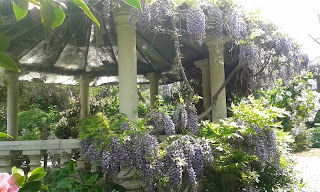Well, last week should have been all about weeding, cutting back, cutting box hedges and planting but all came to a halt last Wednesday when I needed to be at the bedside of my little Grandson in Ch Ch Hospital. Returning home this Wednesday for a brief catch up on things before returning to Ch Ch.
The weeds are starting to mature and make seeds, get them out before they do, and most are easy to pull when they have grown a bit. I am still battling with biddy bid and convolvulus. Spray convolvulus where you can, round up will destroy so far back along roots, but not all the way so just keep zapping it as it pops up. When it grows up through plants I untangle back to the root and direct the regrowth away from the plant.
Divided clumps of violas because they have finished flowering now; I just dig up part of a large clump and pull it to bits basically. You can gently pull masses of new young plants out of the clump and plant them out separately in a cool shady part of the garden. they will soon form their own small cluster which can be planted out next year to flower where you want them.The same for pollyanthas and primulas, break up clumps; plant out only fresh new growth and throw away knotted old spent growth.
There is still time to divide agapanthus, large and dwarf varieties. they can get a bit clump bound which reduces their flowering.
Dig out the whole clump (if it is still manageable enough to do this), then pull off smaller root balls and plant out on their own using fresh compost to get the roots going again. Agapanthus are great gap fillers in new gardens, they can always be removed as you fill your garden with permanent plants.
If you have some aged compost that has finished working and is ready to put on your garden you will be able to make some economical compost tea.
Compost Tea is a nutritionally rich, well-balanced, organic plant food made by steeping aged compost in water. The water is then diluted and used as a root and/or foliar feed. It is also noted for its ability to control various plant diseases (blights, molds, wilts, etc. when used as a foliar spray), to repel and control insect pests and their damage when used on a regular basis, and to encourage the growth of beneficial soil bacteria which results in healthier, more stress-tolerant plants. The basic recipe most often recommended is as follows:
1 large container with lid (plastic rubbish bin works well) enough aged, completed compost to fill an old pillow case 1/2-3/4 full. Fill the container with water, place the compost into the pillowcase (cheese cloth bag or pantyhose also work well), tie off the top and submerge in the container of water. Cover (to prevent odor and insect problems) and let steep for a MINIMUM of 2 weeks. This steeping time is crucial to the formation of beneficial bacteria and the required fermentation process. When finished, dip out the tea and dilute it (3 parts water to 1 part tea) and use as root food for any and all plants on a weekly or as-needed basis.
To use as a foliar spray or on young seedlings dilute it a little more. The remaining tea can continue to steep until needed. The following factors will determine the quality of the finished tea: Use well-aged, finished compost - Fresh compost can burn the plants or contain harmful pathogens and compost past its best will be nutritionally deficient. The contents of the compost should be balanced. If using purchased compost it should contain a portion of aged animal manure which apparently remains active longer than compost made up only of plant matter.
(It is important to note that COMPOST TEA AND MANURE TEA ARE NOT THE SAME THING. Manure tea can be made in the same way but is not generally recommended as foliar spray and is not as nutritionally well-balanced.) Never apply as a foliar spray in the heat of the day but apply to the roots any time.
Next week I will write about companion planting in the vegetable garden.
Veg: Keep the water up and continue planting out. Mound potatoes and remember early potatoes can be dug when flowering but late session potatoes are left until all green tops have died down.
Cheers, Linda





